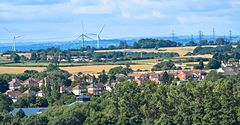Hellaby
| Hellaby | |
|---|---|
 Houses in Hellaby |
|
| Hellaby shown within South Yorkshire | |
| Population | 825 (2011 Census) |
| • London | 145 mi (233 km) south |
| Civil parish |
|
| Metropolitan borough | |
| Metropolitan county | |
| Region | |
| Country | England |
| Sovereign state | United Kingdom |
| Post town | ROTHERHAM |
| Postcode district | S66 |
| Dialling code | 01709 |
| Police | South Yorkshire |
| Fire | South Yorkshire |
| Ambulance | Yorkshire |
| EU Parliament | Yorkshire and the Humber |
| UK Parliament | |
Hellaby is a civil parish in the Metropolitan Borough of Rotherham, South Yorkshire, England. The population of the Civil Parish at the 2011 census was 825. It is situated 4.5 miles (7.2 km) east from the centre of Rotherham and forms a continuous urban area with Maltby, separated from the rest of Rotherham by Junction 1 (Bramley Interchange) of the M18. It is situated by Hellaby Brook and, whilst signposted as "Hellaby Village", the parish has no school, church or post office.
The name Hellaby is formed from "Helgebi", the Domesday orthography by which Norman scribes attempted to express a sound. "Helgebi" was noted in the Domesday Book of 1086 as being within the Parish of Stainton and entrusted by Roger de Busli, who was instrumental in the founding of nearby Roche Abbey, whose foundations were laid in 1147.
Although mentioned in the Domesday Book dated back nine hundred years, the ending of the name in "bi" would indicate a Scandinavian influence and settlement that would have been standing many years previous to this.
The Humber would have proved an ideal landing point with followers of the Vikings, "helgi" and "mault" (Maltby), sailing up the Rivers Trent and Idle and establishing themselves in the nearby limestone valleys with their clear waters and fertile soil. The "Helgebi" settlement would have been built around the nearby streams with land being used for cultivation, woodland and grazing and it is doubtful whether the combined population of the two settlements would have exceeded two hundred souls.
Part of the present Hellaby Hall estate is listed with English Heritage as the deserted site of a Medieval village, with the remains of a well, square ditched enclosure, example of ridge and furrow ploughing method, post Medieval long house, corn drying oven and indications of metal working.
Located between the highway and the hall, recent excavations revealed five plots and croft remains, which could have been used for domestic use with recovered pottery sherds identifying occupation between the 10th and 15th centuries. The crafts had been constructed of freestanding, limestone blocks, infilled with rubble.
...
Wikipedia

